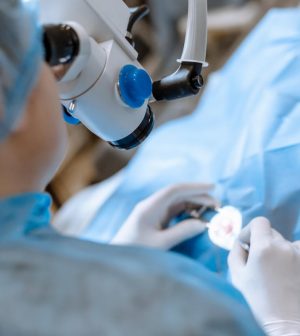- Navigating Your Midlife Crisis: Embracing New Possibilities
- City Raccoons Showing Signs of Domestication
- Mapping the Exposome: Science Broadens Focus to Environmental Disease Triggers
- One Week Less on Social Media Linked to Better Mental Health
- Your Brain Changes in Stages as You Age, Study Finds
- Some Suicide Victims Show No Typical Warning Signs, Study Finds
- ByHeart Formula Faces Lawsuits After Babies Sickened With Botulism
- Switch to Vegan Diet Could Cut Your Greenhouse Gas Emissions in Half
- Regular Bedtime Does Wonders for Blood Pressure
- Dining Alone Could Mean Worse Nutrition for Seniors
Doctors Used See-Through Plastic ‘Window’ to Monitor Injured Man’s Brain

California skateboarder Jared Hager has become the first person to receive a transparent skull replacement, which allows doctors to better view the function of his brain.
The window has allowed doctors to both monitor his progress and test new and better scanning methods for assessing brain health.
Hager, 39, of Downey, Calif., sustained a traumatic brain injury from a skateboarding accident at a Palm Springs reservoir in April 2019.
“I just went down this hill without even looking at it, which is like a really dumb thing to do,” Hager told ABC News.
During emergency surgery, half of Hager’s skull was removed to relieve pressure on his brain.
Doctors had planned to replace the skull bone once Hager recovered, but the pandemic derailed those plans. Elective surgeries were halted, leaving Hager with just skin and connective tissue protecting his brain for two years.
“Even if a stick hits my head, it’s just my brain right here. It’s just my brain.” Hager recalled.
But the timing made Hager a perfect candidate to receive an experimental skull implant made of a material that resembles plexiglass.
Through this “window,” doctors have tested new ultrasound and CT techniques that produce high-resolution brain images.
These brain imaging scans collect data on brain activity by measuring changes in blood flow or electrical impulses. They can provide key insights into how the brain works, both in healthy people and those with brain damage or disease, researchers said.
“This is the first time anyone had applied functional ultrasound imaging through a skull replacement in an awake, behaving human performing a task,” said Dr. Charles Liu, director of the University of Southern California Neurorestoration Center.
Researchers asked Hager to solve a “connect-the-dots” puzzle on a computer monitor and play a few melodies on his guitar, using functional ultrasound imaging to track his brain activity.
“The ability to extract this type of information noninvasively through a window is pretty significant, particularly since many of the patients who require skull repair have or will develop neurological disabilities,” Liu said in a university news release.
Researchers believe that ultrasound and CT techniques using such a window could provide better information than MRI or EEG scans through opaque bone or skull replacements.
“In addition, ‘windows’ can be surgically implanted in patients with intact skulls if functional information can help with diagnosis and treatment,” Liu added. “If we can extract functional information through a patient’s skull implant, that could allow us to provide treatment more safely and proactively.”
For example, such a window could help doctors track the progress of a patient who’s received an electrode implant or some other type of brain surgery.
“One of the big problems when we do these surgeries is that a blood clot can form underneath the implant, but having a clear window gives us an easy way to monitor that,” said researcher Dr. Jonathan Russin, director of cerebrovascular surgery at Keck Hospital of USC.
The findings were published May 29 in the journal Science Translational Medicine.
The researchers praised Hager’s open-mindedness in agreeing to the transparent skull replacement.
“Jared is an amazing guy,” Liu said. “His contributions have really helped us explore new frontiers that we hope can ultimately help many other patients.”
More information
Indiana University Bloomington has more on neuroimaging.
SOURCE: University of Southern California, news release, May 29, 2024
Source: HealthDay
Copyright © 2025 HealthDay. All rights reserved.










